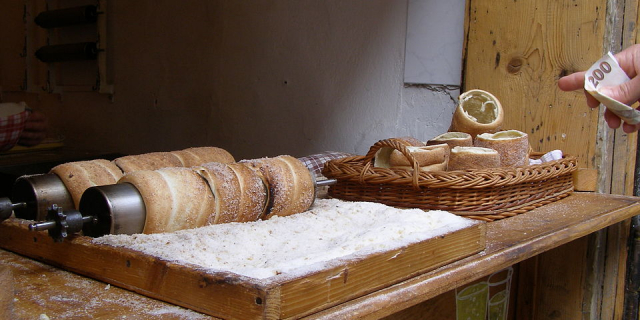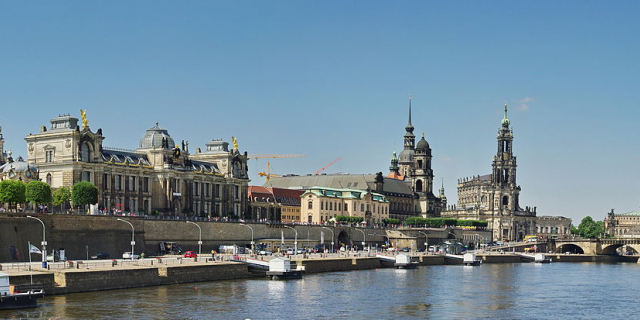Česko
Czech RepublicContext of Czech Republic
The Czech Republic, also known as Czechia, is a landlocked country in Central Europe. Historically known as Bohemia, it is bordered by Austria to the south, Germany to the west, Poland to the northeast, and Slovakia to the southeast. The Czech Republic has a hilly landscape that covers an area of 78,871 square kilometers (30,452 sq mi) with a mostly temperate continental and oceanic climate. The capital and largest city is Prague; other major cities and urban areas include Brno, Ostrava, Plzeň and Liberec.
The Duchy of Bohemia was founded in the late 9th century under Great Moravia. It was formally recognized as an Imperial State of the Holy Roman Empire in 1002 and became a kingdom in 1198. Following the Battle of Mohács in 1526, the whole Crown of Bohemia was gradually integrated into the Habsburg monarchy. The Protestant Bohemian Revolt led to the Thirty Years' War. After the Battle of White M...Read more
The Czech Republic, also known as Czechia, is a landlocked country in Central Europe. Historically known as Bohemia, it is bordered by Austria to the south, Germany to the west, Poland to the northeast, and Slovakia to the southeast. The Czech Republic has a hilly landscape that covers an area of 78,871 square kilometers (30,452 sq mi) with a mostly temperate continental and oceanic climate. The capital and largest city is Prague; other major cities and urban areas include Brno, Ostrava, Plzeň and Liberec.
The Duchy of Bohemia was founded in the late 9th century under Great Moravia. It was formally recognized as an Imperial State of the Holy Roman Empire in 1002 and became a kingdom in 1198. Following the Battle of Mohács in 1526, the whole Crown of Bohemia was gradually integrated into the Habsburg monarchy. The Protestant Bohemian Revolt led to the Thirty Years' War. After the Battle of White Mountain, the Habsburgs consolidated their rule. With the dissolution of the Holy Empire in 1806, the Crown lands became part of the Austrian Empire.
In the 19th century, the Czech lands became more industrialized, and in 1918 most of it became part of the First Czechoslovak Republic following the collapse of Austria-Hungary after World War I. Czechoslovakia was the only country in Central and Eastern Europe to remain a parliamentary democracy during the entirety of the interwar period. After the Munich Agreement in 1938, Nazi Germany systematically took control over the Czech lands. Czechoslovakia was restored in 1945 and three years later became an Eastern Bloc communist state following a coup d'état in 1948. Attempts to liberalize the government and economy were suppressed by a Soviet-led invasion of the country during the Prague Spring in 1968. In November 1989, the Velvet Revolution ended communist rule in the country and restored Democracy. On 31 December 1992, Czechoslovakia was peacefully dissolved, with its constituent states becoming the independent states of the Czech Republic and Slovakia.
The Czech Republic is a unitary parliamentary republic and developed country with an advanced, high-income social market economy. It is a welfare state with a European social model, universal health care and free-tuition university education. It ranks 32nd in the Human Development Index. The Czech Republic is a member of the United Nations, NATO, the European Union, the OECD, the OSCE, and the Council of Europe.
More about Czech Republic
- Currency Czech koruna
- Native name Česko
- Calling code +420
- Internet domain .cz
- Mains voltage 230V/50Hz
- Democracy index 7.67
- Population 2000000
- Area 78866
- Driving side right
- PrehistoryPrehistoryRead lessLeft: Venus of Dolní Věstonice dated to 29,000–25,000 BCE
Right: The stone head of a Celt is among the archaeological collections of the National Museum.[1]Archaeologists have found evidence of prehistoric human settlements in the area, dating back to the Paleolithic era.
In the classical era, as a result of the 3rd century BC Celtic migrations, Bohemia became associated with the Boii.[2] The Boii founded an oppidum near the site of modern Prague.[3] Later in the 1st century, the Germanic tribes of the Marcomanni and Quadi settled there.[4]
Slavs from the Black Sea–Carpathian region settled in the area (their migration was pushed by an invasion of peoples from Siberia and Eastern Europe into their area:[5] Huns, Avars, Bulgars and Magyars).[6] In the sixth century, the Huns had moved westwards into Bohemia, Moravia, and some of present-day Austria and Germany.[6]
During the 7th century, the Frankish merchant Samo, supporting the Slavs fighting against nearby settled Avars,[7] became the ruler of the first documented Slavic state in Central Europe, Samo's Empire. The principality of Great Moravia, controlled by Moymir dynasty, arose in the 8th century.[8] It reached its zenith in the 9th (during the reign of Svatopluk I of Moravia), holding off the influence of the Franks. Great Moravia was Christianized, with a role being played by the Byzantine mission of Cyril and Methodius. They codified the Old Church Slavonic language, the first literary and liturgical language of the Slavs, and the Glagolitic alphabet.[9]
Bohemia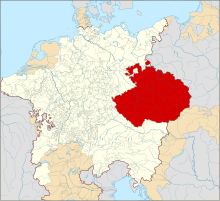 The Crown of Bohemia within the Holy Roman Empire (1600). The Czech lands were part of the Empire in 1002–1806, and Prague was the imperial seat in 1346–1437 and 1583–1611.
The Crown of Bohemia within the Holy Roman Empire (1600). The Czech lands were part of the Empire in 1002–1806, and Prague was the imperial seat in 1346–1437 and 1583–1611.The Duchy of Bohemia emerged in the late 9th century when it was unified by the Přemyslid dynasty. Bohemia was from 1002 until 1806 an Imperial State of the Holy Roman Empire.[10]
In 1212, Přemysl Ottokar I extracted the Golden Bull of Sicily from the emperor, confirming Ottokar and his descendants' royal status; the Duchy of Bohemia was raised to a Kingdom.[11] German immigrants settled in the Bohemian periphery in the 13th century.[12] The Mongols in the invasion of Europe carried their raids into Moravia but were defensively defeated at Olomouc.[13]
After a series of dynastic wars, the House of Luxembourg gained the Bohemian throne.[14]
Efforts for a reform of the church in Bohemia started already in the late 14th century. Jan Hus's followers seceded from some practices of the Roman Church and in the Hussite Wars (1419–1434) defeated five crusades organized against them by Sigismund. During the next two centuries, 90% of the population in Bohemia and Moravia were considered Hussites. The pacifist thinker Petr Chelčický inspired the movement of the Moravian Brethren (by the middle of the 15th century) that completely separated from the Roman Catholic Church.[15]
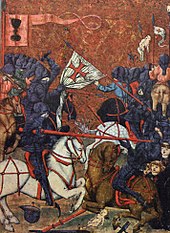 Battle between Hussites and crusaders during the Hussite Wars; Jena Codex, 15th century
Battle between Hussites and crusaders during the Hussite Wars; Jena Codex, 15th centuryOn 21 December 1421, Jan Žižka, a successful military commander and mercenary, led his group of forces in the Battle of Kutná Hora, resulting in a victory for the Hussites. He is honoured to this day as a national hero.
After 1526 Bohemia came increasingly under Habsburg control as the Habsburgs became first the elected and then in 1627 the hereditary rulers of Bohemia. Between 1583 and 1611 Prague was the official seat of the Holy Roman Emperor Rudolf II and his court.
The Defenestration of Prague and subsequent revolt against the Habsburgs in 1618 marked the start of the Thirty Years' War. In 1620, the rebellion in Bohemia was crushed at the Battle of White Mountain and the ties between Bohemia and the Habsburgs' hereditary lands in Austria were strengthened. The leaders of the Bohemian Revolt were executed in 1621. The nobility and the middle class Protestants had to either convert to Catholicism or leave the country.[16]
The following era of 1620 to the late 18th century became known as the "Dark Age". During the Thirty Years' War, the population of the Czech lands declined by a third through the expulsion of Czech Protestants as well as due to the war, disease and famine.[17] The Habsburgs prohibited all Christian confessions other than Catholicism.[18] The flowering of Baroque culture shows the ambiguity of this historical period. Ottoman Turks and Tatars invaded Moravia in 1663.[19] In 1679–1680 the Czech lands faced the Great Plague of Vienna and an uprising of serfs.[20]
 The 1618 Defenestration of Prague marked the beginning of the Bohemian Revolt against the Habsburgs and therefore the first phase of the Thirty Years' War.
The 1618 Defenestration of Prague marked the beginning of the Bohemian Revolt against the Habsburgs and therefore the first phase of the Thirty Years' War.There were peasant uprisings influenced by famine.[21] Serfdom was abolished between 1781 and 1848. Several battles of the Napoleonic Wars took place on the current territory of the Czech Republic.
The end of the Holy Roman Empire in 1806 led to degradation of the political status of Bohemia which lost its position of an electorate of the Holy Roman Empire as well as its own political representation in the Imperial Diet.[22] Bohemian lands became part of the Austrian Empire. During the 18th and 19th century the Czech National Revival began its rise, with the purpose to revive Czech language, culture, and national identity. The Revolution of 1848 in Prague, striving for liberal reforms and autonomy of the Bohemian Crown within the Austrian Empire, was suppressed.[23]
It seemed that some concessions would be made also to Bohemia, but in the end, the Emperor Franz Joseph I affected a compromise with Hungary only. The Austro-Hungarian Compromise of 1867 and the never realized coronation of Franz Joseph as King of Bohemia led to a disappointment of some Czech politicians.[23] The Bohemian Crown lands became part of the so-called Cisleithania.
The Czech Social Democratic and progressive politicians started the fight for universal suffrage. The first elections under universal male suffrage were held in 1907.[24]
Czechoslovakia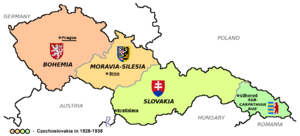 The First Czechoslovak Republic comprised 27% of the population of the former Austria-Hungary and nearly 80% of the industry.[25]
The First Czechoslovak Republic comprised 27% of the population of the former Austria-Hungary and nearly 80% of the industry.[25]In 1918, during the collapse of the Habsburg monarchy at the end of World War I, the independent republic of Czechoslovakia, which joined the winning Allied powers, was created, with Tomáš Garrigue Masaryk in the lead.[26] This new country incorporated the Bohemian Crown.[27]
The First Czechoslovak Republic comprised only 27% of the population of the former Austria-Hungary, but nearly 80% of the industry, which enabled it to compete with Western industrial states.[25] In 1929 compared to 1913, the gross domestic product increased by 52% and industrial production by 41%. In 1938 Czechoslovakia held 10th place in the world industrial production.[28] Czechoslovakia was the only country in Central and Eastern Europe to remain a liberal democracy throughout the entire interwar period.[29] Although the First Czechoslovak Republic was a unitary state, it provided certain rights to its minorities, the largest being Germans (23.6% in 1921), Hungarians (5.6%) and Ukrainians (3.5%).[30]
 Prague during the 1968 Warsaw Pact invasion of Czechoslovakia
Prague during the 1968 Warsaw Pact invasion of CzechoslovakiaWestern Czechoslovakia was occupied by Nazi Germany, which placed most of the region into the Protectorate of Bohemia and Moravia. The Protectorate was proclaimed part of the Third Reich, and the president and prime minister were subordinated to Nazi Germany's Reichsprotektor. One Nazi concentration camp was located within the Czech territory at Terezín, north of Prague. The vast majority of the Protectorate's Jews were murdered in Nazi-run concentration camps. The Nazi Generalplan Ost called for the extermination, expulsion, Germanization or enslavement of most or all Czechs for the purpose of providing more living space for the German people.[31] There was Czechoslovak resistance to Nazi occupation as well as reprisals against the Czechoslovaks for their anti-Nazi resistance. The German occupation ended on 9 May 1945, with the arrival of the Soviet and American armies and the Prague uprising.[32] Most of Czechoslovakia's German-speakers were forcibly expelled from the country, first as a result of local acts of violence and then under the aegis of an "organized transfer" confirmed by the Soviet Union, the United States, and Great Britain at the Potsdam Conference.[33]
In the 1946 elections, the Communist Party gained 38%[34] of the votes and became the largest party in the Czechoslovak parliament, formed a coalition with other parties, and consolidated power. A coup d'état came in 1948 and a single-party government was formed. For the next 41 years, the Czechoslovak Communist state conformed to Eastern Bloc economic and political features.[35] The Prague Spring political liberalization was stopped by the 1968 Warsaw Pact invasion of Czechoslovakia. Analysts believe that the invasion caused the communist movement to fracture, ultimately leading to the Revolutions of 1989.
Czech Republic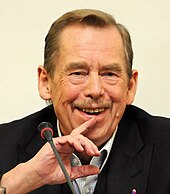 Václav Havel, one of the most important figures in Czech history during the 20th century. Leader of the Velvet Revolution, the last president of Czechoslovakia and the first president of the Czech Republic.
Václav Havel, one of the most important figures in Czech history during the 20th century. Leader of the Velvet Revolution, the last president of Czechoslovakia and the first president of the Czech Republic.In November 1989, Czechoslovakia again became a liberal democracy through the Velvet Revolution. However, Slovak national aspirations strengthened (Hyphen War) and on 31 December 1992, the country peacefully split into the independent countries of the Czech Republic and Slovakia. Both countries went through economic reforms and privatizations, with the intention of creating a market economy, as they have been trying to do since 1990, when Czechs and Slovaks still shared the common state. This process was largely successful; in 2006 the Czech Republic was recognized by the World Bank as a "developed country",[36] and in 2009 the Human Development Index ranked it as a nation of "Very High Human Development".[37]
From 1991, the Czech Republic, originally as part of Czechoslovakia and since 1993 in its own right, has been a member of the Visegrád Group and from 1995, the OECD. The Czech Republic joined NATO on 12 March 1999 and the European Union on 1 May 2004. On 21 December 2007 the Czech Republic joined the Schengen Area.[38]
Until 2017, either the centre-left Czech Social Democratic Party or the centre-right Civic Democratic Party led the governments of the Czech Republic. In October 2017, the populist movement ANO 2011, led by the country's second-richest man, Andrej Babiš, won the elections with three times more votes than its closest rival, the Civic Democrats.[39] In December 2017, Czech president Miloš Zeman appointed Andrej Babiš as the new prime minister.[40]
In the 2021 elections, ANO 2011 was narrowly defeated and Petr Fiala became the new prime minister.[41] He formed a government coalition of the alliance SPOLU (Civic Democratic Party, KDU-ČSL and TOP 09) and the alliance of Pirates and Mayors. In January 2023, retired general Petr Pavel won the presidential election, becoming new Czech president to succeed Miloš Zeman.[42] Following the 2022 Russian invasion of Ukraine, the country took in half a million Ukrainian refugees, the largest number per capita in the world.[43][44]
^ "Top items – Head of a Celt". Muzeum 3000. ^ Rankin, David (2002). Celts and the Classical World. Routledge. p. 16. ISBN 978-1-134-74722-1. ^ Kartografie Praha (Firm) (1997). Praha, plán města. Kartografie Praha. p. 17. ISBN 978-80-7011-468-1. ^ Vasco La Salvia (2007). Iron Making During the Migration Period: The Case of the Lombards. Archaeopress. p. 43. ISBN 978-1-4073-0159-4. ^ Hugh LeCaine Agnew (2004). The Czechs and the Lands of the Bohemian Crown. Hoover Press. p. 37. ISBN 978-0-8179-4492-6. ^ a b Hahn, Sylvia; Nadel, Stanley (2014). Asian Migrants in Europe: Transcultural Connections. V&R unipress GmbH. pp. 7–8. ISBN 978-3-8471-0254-0. ^ Bartl, Július; Škvarna, Dušan (2002). Slovak History: Chronology & Lexicon. Bolchazy-Carducci Publishers. p. 18. ISBN 978-0-86516-444-4. ^ Champion, Tim (2005). Centre and Periphery: Comparative Studies in Archaeology. Routledge. p. 233. ISBN 978-1-134-80679-9. ^ Benedetto, Robert; Duke, James O. (2008). The New Westminster Dictionary of Church History: The early, medieval, and Reformation eras. Westminster John Knox Press. p. 474. ISBN 978-0-664-22416-5. ^ Pánek, Jaroslav; Tůma, Oldřich (2019). A History of the Czech Lands. Charles University in Prague, Karolinum Press. p. 76. ISBN 978-80-246-2227-9. ^ Pánek, Jaroslav; Tůma, Oldřich (2019). A History of the Czech Lands. Charles University in Prague, Karolinum Press. p. 111. ISBN 978-80-246-2227-9. ^ Pánek, Jaroslav; Tůma, Oldřich (2019). A History of the Czech Lands. Charles University in Prague, Karolinum Press. p. 237. ISBN 978-80-246-2227-9. ^ Grousset, René (1970). The Empire of the Steppes. Rutgers University Press. p. 266. ISBN 978-0-8135-1304-1. Retrieved 26 August 2017. ^ "Václav II. český král". panovnici.cz. Archived from the original on 7 September 2011. Retrieved 31 October 2011. ^ "Mentor and precursor of the Reformation". Archived from the original on 4 April 2016. Retrieved 29 April 2016. ^ "Protestantism in Bohemia and Moravia (Czech Republic)". Virtual Museum of Protestantism. Archived from the original on 15 October 2015. Retrieved 25 May 2015. ^ Oskar Krejčí, Martin C. Styan, Ústav politických vied SAV. (2005). Geopolitics of the Central European region: the view from Prague and Bratislava. p.293. ISBN 80-224-0852-2 ^ "RP's History Online – Habsburgs". Archiv.radio.cz. Archived from the original on 17 July 2011. Retrieved 25 April 2010. ^ "History of the Mongols from the 9th to the 19th Century. Part 2. The So-Called Tartars of Russia and Central Asia. Division 1". Henry Hoyle Howorth. p.557. ISBN 1-4021-7772-0 ^ "The new Cambridge modern history: The ascendancy of France, 1648–88". Francis Ludwig Carsten (1979). p.494. ISBN 0-521-04544-4 ^ "The Cambridge economic history of Europe: The economic organization of early modern Europe". E. E. Rich, C. H. Wilson, M. M. Postan (1977). p.614. ISBN 0-521-08710-4 ^ Hlavačka, Milan (2009). "Formování moderního českého národa 1815–1914". Historický Obzor (in Czech). 20 (9/10): 195. ^ a b Cole, Laurence; Unowsky, David (eds.). The Limits of Loyalty: Imperial Symbolism, Popular Allegiances, and State Patriotism in the Late Habsburg Monarchy (PDF). New York, Oxford: Berghahn Books. Archived from the original (PDF) on 25 May 2015. Retrieved 24 May 2015. ^ "Františka Plamínková: the feminist suffragette who ensured Czechoslovakia's Constitution of 1920 lived up to the principle of equality". Radio Prague International. 29 February 2020. Retrieved 5 January 2021. ^ a b Stephen J. Lee. Aspects of European History 1789–1980. Page 107. Chapter "Austria-Hungary and the successor states". Routledge. 28 January 2008. ^ Preclík, Vratislav. Masaryk a legie (Masaryk and legions), váz. kniha, 219 pages, first issue - vydalo nakladatelství Paris Karviná, Žižkova 2379 (734 01 Karviná, Czech Republic) ve spolupráci s Masarykovým demokratickým hnutím (Masaryk Democratic Movement, Prague), 2019, ISBN 978-80-87173-47-3, pages 22–81, 85–86, 111–112, 124–125, 128, 129, 132, 140–148, 184–209. ^ "Tab. 3 Národnost československých státních příslušníků podle žup a zemí k 15 February 1921" (PDF) (in Czech). Czech Statistical Office. Archived from the original (PDF) on 5 June 2007. Retrieved 2 June 2007. ^ "Ekonomika ČSSR v letech padesátých a šedesátých". Blisty.cz. 21 August 1968. Archived from the original on 7 July 2014. Retrieved 14 May 2014. ^ Dijk, Ruud van; Gray, William Glenn; Savranskaya, Svetlana; Suri, Jeremi; Zhai, Qiang (2013). Encyclopedia of the Cold War. Routledge. p. 76. ISBN 978-1135923112. Archived from the original on 22 November 2018. Retrieved 13 December 2017. ^ Rothenbacher, Franz (2002). The European Population 1850–1945. Palgrave Macmillan, London. p. 145. ISBN 978-1-349-65611-0. ^ Chad Bryant (2009) Prague in Black: Nazi Rule and Czech Nationalism (Harvard University Press, 2009), pp 104–178. Snyder, Timothy (2010). Bloodlands: Europe Between Hitler and Stalin. Basic Books. p. 160. ISBN 0465002390 ^ "A Companion to Russian History Archived 6 September 2015 at the Wayback Machine". Abbott Gleason (2009). Wiley-Blackwell. p.409. ISBN 1-4051-3560-3 ^ Chad Bryant (2009) Prague in Black: Nazi Rule and Czech Nationalism (Harvard University Press, 2009), 208–252. ^ F. Čapka: Dějiny zemí Koruny české v datech Archived 20 June 2008 at the Wayback Machine. XII. Od lidově demokratického po socialistické Československo – pokračování. Libri.cz (in Czech) ^ "Czech schools revisit communism". Archived from the original on 4 August 2014. Retrieved 13 September 2014. ^ Velinger, Jan (28 February 2006). "World Bank Marks Czech Republic's Graduation to 'Developed' Status". Radio Prague. Archived from the original on 12 January 2008. Retrieved 22 January 2007. ^ "Human Development Report 2009" (PDF). UNDP.org. January 2009. Archived (PDF) from the original on 22 November 2009. Retrieved 25 April 2010. ^ "EU, NATO, Schengen and Eurozone member states in Europe". 13 October 2018. ^ "Czech election: Billionaire Babis wins by large margin". BBC News. 21 October 2017. ^ "Czech billionaire Andrej Babis named new prime minister". Deutsche Welle. 6 December 2017. ^ "Czech Republic: Petr Fiala named new prime minister". DW.COM. 28 November 2021. ^ "Retired general Petr Pavel wins election to become Czech president". euronews. 28 January 2023. ^ "Regional Refugee Response Plan for the Ukraine Situation - Inter-Agency Operational Update: Czech Republic, July - October 2022". reliefweb. UN Office for the Coordination of Humanitarian Affairs. Retrieved 25 February 2023. ^ Field, Matt. "Ukraine is fighting on behalf of all democracies". GOV.UK. British Embassy Prague. Retrieved 25 February 2023.
- Stay safeTaxi drivers: warning - negotiate the price before you use taxi or use a reputable company (e.g. Liftago, Uber). Prague taxi drivers are known for taking you the longest possible way to earn more money. Prague City Council has introduced new regulations which will see all legitimate taxis painted yellow. Public transportation is also very cheap, fast and reliable. In Prague, the metro runs up to midnight, and night trams run throughout the night, all of them converging at a central tram stop, Lazarská. Pickpockets: Watch your pockets, especially if there is a crowd (sights, subway, trams, in particular numbers 9, 10 and 22) Watch out for large groups of people jostling you. Beware of a particular pickpocket gangs operating in Prague: they are mainly male, although sometimes there are women too; all are extremely overweight and rely on their sheer size and number to disorientate tourists. They tend to operate on the 9, 10 and 22 trams, as well as the central metro stations, usually just as people are getting on and off, or on the escalators. Don't pull out your tickets unless you are specifically asked to do so. And keep your wallet and money securely locked and separate from each other at all time. Don't challenge them as they can become aggressive, but keep your eyes open. Prosecutions for pickpocketing are rare as legally the police have to catch the pickpocket in the middle of a crime. Prostitution: Prostitution is not illegal in the Czech Republic. However, officially prostitution does not exist as a legal business. Prostitutes do not pay taxes and prostitution is not regulated by the state. The health risk may be very high, especially in cheap brothels or on the street....Read more
 Yellow taxis outside a yellow building in PragueStay safeRead lessTaxi drivers: warning - negotiate the price before you use taxi or use a reputable company (e.g. Liftago, Uber). Prague taxi drivers are known for taking you the longest possible way to earn more money. Prague City Council has introduced new regulations which will see all legitimate taxis painted yellow. Public transportation is also very cheap, fast and reliable. In Prague, the metro runs up to midnight, and night trams run throughout the night, all of them converging at a central tram stop, Lazarská. Pickpockets: Watch your pockets, especially if there is a crowd (sights, subway, trams, in particular numbers 9, 10 and 22) Watch out for large groups of people jostling you. Beware of a particular pickpocket gangs operating in Prague: they are mainly male, although sometimes there are women too; all are extremely overweight and rely on their sheer size and number to disorientate tourists. They tend to operate on the 9, 10 and 22 trams, as well as the central metro stations, usually just as people are getting on and off, or on the escalators. Don't pull out your tickets unless you are specifically asked to do so. And keep your wallet and money securely locked and separate from each other at all time. Don't challenge them as they can become aggressive, but keep your eyes open. Prosecutions for pickpocketing are rare as legally the police have to catch the pickpocket in the middle of a crime. Prostitution: Prostitution is not illegal in the Czech Republic. However, officially prostitution does not exist as a legal business. Prostitutes do not pay taxes and prostitution is not regulated by the state. The health risk may be very high, especially in cheap brothels or on the street. There also have been cases of prostitutes offering a drink with sleeping pills to their customers and stealing everything from them. Pay attention to the age of the prostitute, paying a person under 18 years for sex is a criminal offense (otherwise the age of consent is 15). Marijuana: Marijuana is basically illegal in the Czech Republic, but it is quite popular especially among young people. In case the police catch you smoking or possessing marijuana, you want to be very polite with them. The reason is that by the current law, possessing only a "larger than small" amount of marijuana is a criminal offence. A "larger than small" amount of marijuana is defined as more than 15 g. Some areas inhabited prevalently by poor, homeless and disadvantaged sections of the society are deemed unsafe. In such places, there is somewhat increased danger of pockets, robbery or even rape. Whole quarters are affected in some cities of North Bohemia (Most, Litvínov, Ústí nad Labem) or in Ostrava. Expressing denial or approval for genocide or crimes against humanity is illegal and may carry a prison sentence of up to three years. Czech authorities have indicated that this law may apply to those publicly expressing support for Russia's invasion of Ukraine. Other than that, the Czech Republic is a very safe country.
Yellow taxis outside a yellow building in PragueStay safeRead lessTaxi drivers: warning - negotiate the price before you use taxi or use a reputable company (e.g. Liftago, Uber). Prague taxi drivers are known for taking you the longest possible way to earn more money. Prague City Council has introduced new regulations which will see all legitimate taxis painted yellow. Public transportation is also very cheap, fast and reliable. In Prague, the metro runs up to midnight, and night trams run throughout the night, all of them converging at a central tram stop, Lazarská. Pickpockets: Watch your pockets, especially if there is a crowd (sights, subway, trams, in particular numbers 9, 10 and 22) Watch out for large groups of people jostling you. Beware of a particular pickpocket gangs operating in Prague: they are mainly male, although sometimes there are women too; all are extremely overweight and rely on their sheer size and number to disorientate tourists. They tend to operate on the 9, 10 and 22 trams, as well as the central metro stations, usually just as people are getting on and off, or on the escalators. Don't pull out your tickets unless you are specifically asked to do so. And keep your wallet and money securely locked and separate from each other at all time. Don't challenge them as they can become aggressive, but keep your eyes open. Prosecutions for pickpocketing are rare as legally the police have to catch the pickpocket in the middle of a crime. Prostitution: Prostitution is not illegal in the Czech Republic. However, officially prostitution does not exist as a legal business. Prostitutes do not pay taxes and prostitution is not regulated by the state. The health risk may be very high, especially in cheap brothels or on the street. There also have been cases of prostitutes offering a drink with sleeping pills to their customers and stealing everything from them. Pay attention to the age of the prostitute, paying a person under 18 years for sex is a criminal offense (otherwise the age of consent is 15). Marijuana: Marijuana is basically illegal in the Czech Republic, but it is quite popular especially among young people. In case the police catch you smoking or possessing marijuana, you want to be very polite with them. The reason is that by the current law, possessing only a "larger than small" amount of marijuana is a criminal offence. A "larger than small" amount of marijuana is defined as more than 15 g. Some areas inhabited prevalently by poor, homeless and disadvantaged sections of the society are deemed unsafe. In such places, there is somewhat increased danger of pockets, robbery or even rape. Whole quarters are affected in some cities of North Bohemia (Most, Litvínov, Ústí nad Labem) or in Ostrava. Expressing denial or approval for genocide or crimes against humanity is illegal and may carry a prison sentence of up to three years. Czech authorities have indicated that this law may apply to those publicly expressing support for Russia's invasion of Ukraine. Other than that, the Czech Republic is a very safe country. Yellow taxis outside a yellow building in Prague
Yellow taxis outside a yellow building in Prague
















